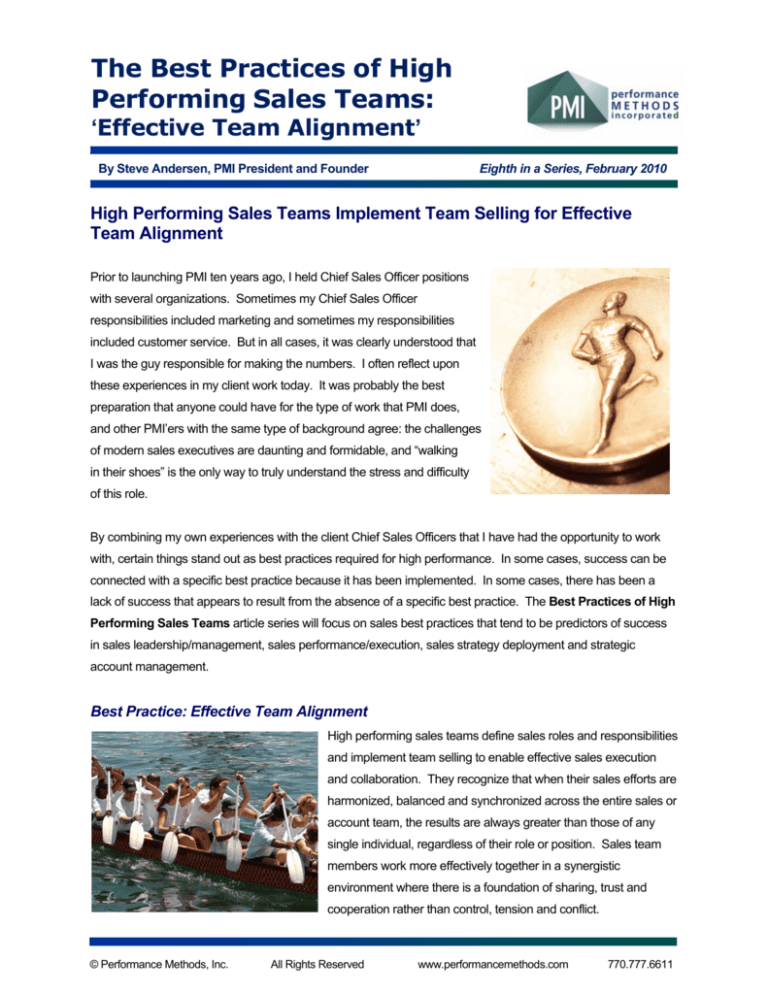
The Best Practices of High
Performing Sales Teams:
‘Effective Team Alignment’
By Steve Andersen, PMI President and Founder
Eighth in a Series, February 2010
High Performing Sales Teams Implement Team Selling for Effective
Team Alignment
Prior to launching PMI ten years ago, I held Chief Sales Officer positions
with several organizations. Sometimes my Chief Sales Officer
responsibilities included marketing and sometimes my responsibilities
included customer service. But in all cases, it was clearly understood that
I was the guy responsible for making the numbers. I often reflect upon
these experiences in my client work today. It was probably the best
preparation that anyone could have for the type of work that PMI does,
and other PMI’ers with the same type of background agree: the challenges
of modern sales executives are daunting and formidable, and “walking
in their shoes” is the only way to truly understand the stress and difficulty
of this role.
By combining my own experiences with the client Chief Sales Officers that I have had the opportunity to work
with, certain things stand out as best practices required for high performance. In some cases, success can be
connected with a specific best practice because it has been implemented. In some cases, there has been a
lack of success that appears to result from the absence of a specific best practice. The Best Practices of High
Performing Sales Teams article series will focus on sales best practices that tend to be predictors of success
in sales leadership/management, sales performance/execution, sales strategy deployment and strategic
account management.
Best Practice: Effective Team Alignment
High performing sales teams define sales roles and responsibilities
and implement team selling to enable effective sales execution
and collaboration. They recognize that when their sales efforts are
harmonized, balanced and synchronized across the entire sales or
account team, the results are always greater than those of any
single individual, regardless of their role or position. Sales team
members work more effectively together in a synergistic
environment where there is a foundation of sharing, trust and
cooperation rather than control, tension and conflict.
© Performance Methods, Inc.
All Rights Reserved
www.performancemethods.com
770.777.6611
Team Play vs. Individual Heroics
In most business-to-business selling environments that we see today, there is a selling or account team
representing the supplier attempting to connect with a buying or decision team representing the customer. Why
is this alignment between the supplier’s team and the customer’s team so difficult for most sales organizations?
We feel that it begins with a lack of internal alignment within the supplier’s own team members – which can
result from ill-defined roles, conflicting goals and compensation plans, account control issues, as well as a
number of other factors. When the selling/account team is not aligned internally, it is difficult for team members
to sell together as a synchronized unit and this typically does not go unnoticed by the customer.
Customers tell us that when they sense that their “supplier team” is
not aligned it creates a sense of concern regarding the supplier’s
ability to set realistic expectations, execute and deliver results.
Lack of effective teamwork invariably creates situations where
certain individuals have to perform at higher levels to meet
customer needs, and as we all know, individual heroics are
typically difficult to predict or forecast. Most customers will tell you
that they prefer to deal with a functional and harmonized supplier
team than to depend on a few top performers to continually save
the day. In short, effective teamwork can reduce the customer’s
feelings of risk and exposure, and provide the supplier with more balanced sales performance as a result.
Taking the Field
Before a team can align effectively it must be developed and structured, and this means that the team must
understand “who does what” and how the sum of the talents and skills of the team members create a force
much stronger than that of any individual. Customer-facing supplier teams are typically organized with specific
objectives in mind, including the pursuit of new sales opportunities, the development of long-term account
relationships and the delivery of solutions and services after the sale. In each of these, it is important to ensure
that the members of the team understand their role or “position” and how it relates to overall team performance.
Customers tell us that they appreciate the opportunity to have a
voice in the determination of the supplier’s team. Since resources
and expertise are always key factors in the creation of customerspecific value (please see Article 7 in this series: Customer Value
Focus), it’s important to consider fit and ultimate team-to-team
alignment with the customer when selecting the right resources for
your customer-facing team. And keep this in mind: sometimes it’s
better to build a team that can take the field and perform effectively
together even if it means that you pass on certain “position
players” that may be best in class but not necessarily a good fit when it comes to working effectively with the
rest of your team or with your customer.
© Performance Methods, Inc.
All Rights Reserved
www.performancemethods.com
770.777.6611
Calling the Plays
Show me a team that is well-aligned and consistently creating customer-specfic
value and I’ll show you a team that has an appreciation for the importance of team
leadership, including the role of the team quarterback. It’s the same in sales as it is
in sports: people respond to effective leadership, particularly when the leader is
personally involved, able to demonstrate best practices and willing to take the time
to understand other team members and what’s important to each of them.
All too often, sales teams are put into pressurized situations where there doesn’t
seem to be enough time to “do things right” due to customer requirements that
result in tight timeframes and difficult deadlines. Someone has to be in a position of
leading the team and ultimately calling the plays – and our experience is that in most cases, sales teams benefit
from effective “play calling” by the person in the roll of team quarterback.
This doesn’t mean that this individual has all of the answers or is even the ranking member of the team – but it
does mean that this individual is in the role of “strategy owner” for the opportunity or account at hand. In most
selling environments that we see today, this responsibility of strategy owner typically resides with the account
executive or strategic account manager, particularly as strategy relates to winning new sales opportunities or
growing relationships with strategic customers.
Playing to Win
So now that we’ve built our team and defined our roles, how do we optimize team performance? Many of us
have been asked in the past to join teams that lacked focus and failed to execute with consistency – and these
types of situations can negatively impact personal productivity and result in the creation of potential conflicts with
other team members.
We find that the best way to avoid this is to ensure that there is a clearly defined
and communicated strategy that all team members understand and support. A
sales or account team that is well-aligned should have good connection between
individual team members in areas that can include customer problem solving,
customer relationship building and customer communication and collaboration,
among others.
These team members realize that it’s more important to win than it is to be right –
a truism that was shared by a client in this way:
“At the end of the day we measure results in terms of customer value creation,
not in terms of who had the best ideas on our sales and account teams. It’s
when we work this way that our customers see us at our best.”
© Performance Methods, Inc.
All Rights Reserved
www.performancemethods.com
770.777.6611
Coaching Effective Team Alignment
How can sales management and leadership contribute to effective team alignment?
We all recognize the importance of effective sales coaching in today’s challenging
selling environment (please see Article 2 in this series: Effective Sales Coaching),
but in many cases this coaching takes on the form of assessing sales opportunities
and reviewing strategic or key accounts.
We suggest that the effective sales coach “tune in” early when sales and account
teams are being formed and assist the teams in determining priorities and
identifying potential obstacles before problems begin. Coaching team alignment
may not be as intuitive for the typical sales coach as “coaching to win” sales
opportunities or “coaching to grow” strategic customer relationships, so here are a few tips to keep in mind:
Confirm that the value to the team of each individual member is clear, as is their primary role and
responsibilities.
Ensure that the value to the customer of each individual member is clear, as are their primary
connection points with targeted customer buying and decision team members.
Validate that there is an effective strategy in place that the team will pursue: this may be a competitive
strategy to win a specific sales opportunity or a growth strategy to evolve a strategic customer
relationship to the next level.
Checkpoint with the team quarterback or leader that they are communicating regularly and clearly with
other team members, and that they are refraining from calling too many last-minute “audible plays at
the line of scrimmage” that may be unclear to the team and result in stress and confusion.
Never usurp the authority or role of the team leader in front of the rest of the team – even if you
disagree with them. The best approach for “coaching your quarterback” is one-on-one and away from
the rest of the team.
Conclusion
High performing sales teams define roles and responsibilities and implement team selling to enable effective
sales execution and collaboration. They understand that a balanced and synchronized sales team will be more
consistent in their creation of customer value and development of deeper and wider customer relationships.
Effective team alignment requires effort – it’s not easy. But the sustained competitive advantages of
implementing team selling within well-aligned sales and account teams is quite compelling, and the impact of
effective team alignment on key customer relationships can be a significant differentiator in markets where
customers have difficulty distinguishing one supplier’s solution from another’s.
Alignment with customers should be an early objective of every sales and account team, and one thing is
certain: if we aren’t effectively aligned internally within our own team, the likelihood of aligning effectively
externally with the customer’s team is quite remote.
© Performance Methods, Inc.
All Rights Reserved
www.performancemethods.com
770.777.6611
Next Month
Our next article will extend team selling and alignment into the discovery and creation of new opportunities. In
Cross Sell and Leverage the “Whole,” we will examine how high performing sales teams leverage their
Effective Team Alignment, Consultative Selling Skills and Proven Sales Best Practices to ensure that
their sales efforts maintain a strong Customer Value Focus (Articles 5, 6, 7 and 8 in this series).
Performance Methods, Inc., recognized by TrainingIndustry.com as one
of the 2009 Top Sales Training Companies, will be featured in a series of
articles that will focus on the Best Practices of High Performing Sales
Teams. PMI is proud to serve the needs of a broad group of industryleading companies and will be sharing with the TrainingIndustry.com
readership how leading global firms are deploying proven best practices
to increase sales effectiveness, create customer value, grow customer
relationships and gain competitive advantage. The Best Practices of
High Performing Sales Teams article series will cover a number of critical areas of sales performance and
provide readers with insight into how sales best practices are being deployed effectively by world-class sales
organizations in a variety of industries. These articles will provide special emphasis on key best practices
driving effective sales leadership/management, sales performance/execution, sales strategy deployment and
strategic account management.
© Performance Methods, Inc.
All Rights Reserved
www.performancemethods.com
770.777.6611







